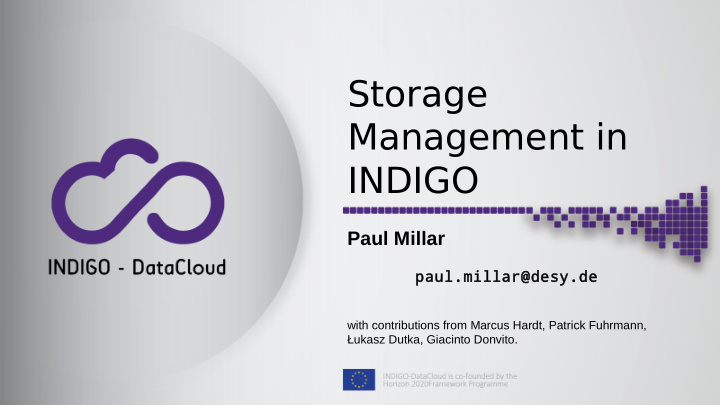



Storage Management in INDIGO Paul Millar paul.millar@desy.de with contributions from Marcus Hardt, Patrick Fuhrmann, Łukasz Dutka, Giacinto Donvito.
INDIGO-DataCloud: cheat sheet ● A Horizon-2020 project Approved: January 2015; Started: April 2015; Ends: September 2017. ● 26 partners from 11 European countries. ● Over €11 million ● Objective : develop an Open-Source platform for computing and data, deployable on public and private cloud infrastructures. ● Requirements from 11 INDIGO communities. More details : http://indigo-datacloud.eu/
The “golden era”
Collaborations & new equipment
More resources, but “cloud”!
Who is involved Biological and medical science ● Biological, molecular and medical imaging, life science research applied to medicine, agriculture, bio-industries and society, structural biology. Social science, arts and humanities ● Georeferencing (e.g., of current and historical maps), cultural heritage, smart sensors. Environment and earth science ● Biodiversity and ecosystem research, interactions between geosphere, biosphere and hydrosphere, earth system modelling. Physical sciences ● Astrophysics, theoretical and experimental research in physics.
How INDIGO-DataCloud helps WP4 : Providing common interfaces for site-local resources IaaS WP5 : Providing a useful, high-level service that combines multiple resources. PaaS
IaaS: Quality of Service Media Quality Access HIGH MEDIUM LOW MEDIUM MEDIUM Latency Durability OK MEDIUM Not so clear Quite OK OK Data rate OK OK MEDIUM OK OK Reasonable Cost Very low Very high MEDIUM MEDIUM
Making the choice meaningful Durability / P data_loss Low latency & lowest price → Class #1 High throughput & super durable → Class #2 Large volume & cheap & archive → Class #3 GUI Discover & Match VS REST { } API Canonical classes Access Latency / ms
Federating QoS Choice PaaS GUI Discover Property & Information Match REST System { } API GUI GUI Discover Discover & & Match Match REST REST { } { } API API IaaS IaaS
IaaS: Data Lifecycle Data Lifecycle is just time dependent changes of Storage Quality of Service Ownership and Access Control: PI Owned, limited access → Site Owned, Public access Payment model: pay-as-you-go → pay-in-advance for rest of lifetime Maybe other things 1 year 10 years 6 m
IaaS: Metadata-driven storage
IaaS: laying hierarchical storage
Ease of deployment Grid computing INDIGO-DataCloud Credit: U.S. Pacific Fleet @ flickr.com Credit: Creative Tools @ flickr.com
Identity and group-membership ● Allow difgerent authentication mechanisms SAML, OpenID-Connect, X.509, ... ● Harmonise user identities: User is the same person, irrespective of how they authenticate ● Support group-membership : Membership can be used for authorisation decisions. ● Support third-party group membership: VOMS-style: where membership not asserted by authentication service. For more details, see Andrea's Talk: “ The Indigo AAI” tomorrow 10:15 in Scuderia.
Availability ● First offjcial release : end of July next year ● We will start making available some services as soon as they are ready enough to be tested ● All the changes on the existing projects will be pushed back to the offjcial releases. OpenStack, OpenNebula, dCache, OneData, Mesos, Accounting, QoS/SLA, etc...
The result: more time researching
Backup slides
PaaS: Unifjed data access ● Data set registrar: Unifjed vision of geographically distributed data set. ● Data affjnity: Computation jobs started on resources close to data. ● Automatic Staging: Replicating data when not close to specialist hardware. ● Optimised streaming access of remote data: When data is not staged. ● API for data and metadata management: registration, migration, replication, sharing; federated ACL management ● Optimised data movement ● Aggregate QoS through replication ● Gateway to external data repositories
PaaS: Unifjed storage interfaces ● Data access methods and protocols: CDMI, Web GUI, WebDAV, S3, POSIX (mounted virtual volume) ● Data locations: via CDMI or WebDAV ● Data migration and replication: REST API or CDMI extension allowing replication based on metadata.
PaaS: Data Affjnity ● Knowledge of where data is located ● Identify which IaaS computing resource is closest ● Allow deployment of computation activity close to where the data is located ● Minimise data transfers to improve effjciency.
Recommend
More recommend